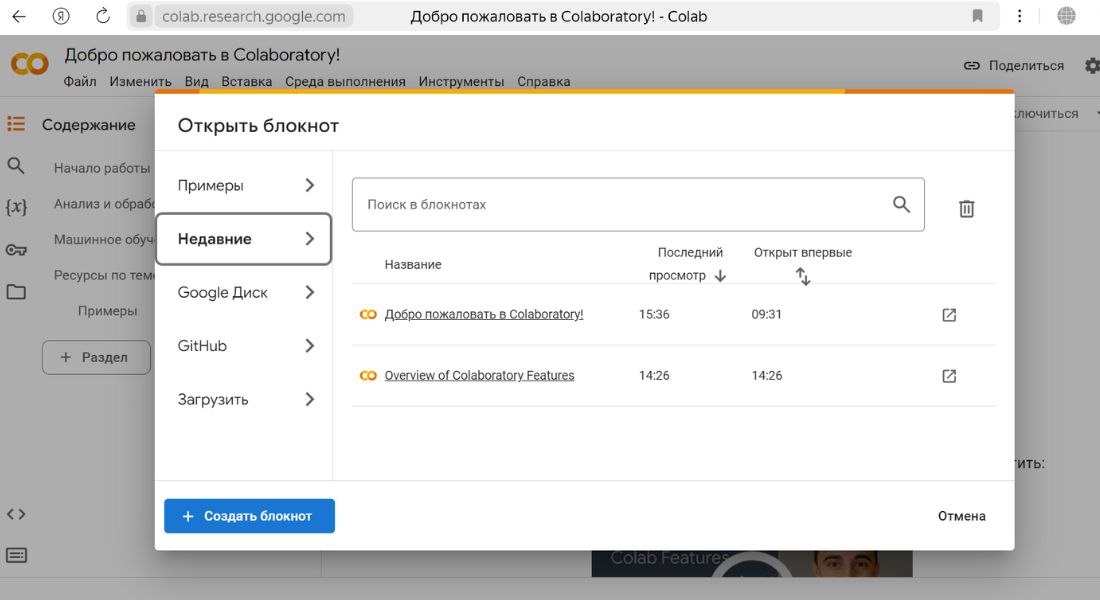Most often, data scientists install a Python environment on their computer, for example, using Anaconda or Miniconda, and then launch a local Jupyter server. An alternative is the ability to use a cloud service with ready-made laptops and the necessary environment, which you can edit online.
That’s exactly what the CoLab notebook offers, a cloud-based Jupyter service within Google CoLaboratory that can be accessed from anywhere in the world to write code or create documentation. Colab is particularly well suited for machine learning, data science and education. Essentially, Google Colab is the Google Docs of the data world.
How can Google Colab change the way you work with data? Let’s figure it out.
What is Google CoLab?
Google CoLab, short for Google Colaboratory, is a free service that allows you to run and develop Python code right in your browser.
It makes it easy to share and work on projects in real time with the others. It is based on the popular Jupyter Notebook framework, making it a convenient tool for working with data science, machine learning, deep learning* and other computing tasks.
Google Colab provides access to Google computing resources, such as graphics processing units (GPUs) and tensor processing units (TPUs), which we’ll look at in more detail in this article.

*Deep learning is a type of machine learning that uses multi-layer artificial neural networks to analyze data.
Google CoLab Features
The essence of CoLab is to create an interactive environment for experimentation, data analysis and model training. Let’s take a look at what you can do with Colab:
- Train neural networks for image and video classification using the TensorFlow or PyTorch libraries;
- Create and train models for text processing (NLTK or SpaCy libraries);
- Explore and visualize collected data using Python libraries (Pandas, Matplotlib and Seaborn);
- Train models to determine language and sentiment features;
- Use Gym libraries to train reinforcement models on environments (game simulators);
- Apply clustering or dimensionality reduction algorithms to analyze data without explicit labels;
- Analyze large data sets, including data from the cloud or BigQuery;
- Process streaming data using Apache Spark.
5 Reasons to Try Google Colab

- Free to use
One of the main advantages of Google Colab is that it is free. Users do not have to pay to use the platform, but there is a limitation: after 12 hours of inactivity, the data on the server is deleted. But you can always save your work on your local device or in cloud storage. The service currently also offers a paid subscription to purchase additional computing time. - Google Drive integration
You can easily import data from your Google Drive or export your data processing results back to it. - Pre-installed libraries
Colab comes pre-installed with many popular machine learning and deep learning libraries such as TensorFlow, PyTorch, Keras, and many more. - GitHub integration
Google Colab integrates with software developers via GitHub. When you provide your profile to the service, you can access any repository on GitHub. - Collaboration and on-the-go comments
As with Jupyter Notebook, Colab allows you to collaborate on projects by sharing code and comments with other users. You can use executable code, HTML markup, and insert images at the same time as your command in one file.
Analogues of Google Colab
Kaggle is a data science plus machine learning competition platform and social network for data scientists and machine learning professionals. They provide a feature called Kernels that allows users to create and run Jupyter Notebooks in the cloud.
Microsoft Azure provides a service called Azure Notebooks that allows users to create and run Jupyter Notebooks in the cloud using Microsoft Azure computing resources.
IBM Watson Studio is a cloud-based platform for developing and deploying machine learning and data analytics models. It provides tools for creating and running Jupyter Notebooks in the cloud using IBM computing resources.
Binder is a service that allows you to turn GitHub repositories with Jupyter Notebooks into interactive runtimes. Users can run Jupyter Notebooks directly in the browser without installing anything locally.
Who works with Google Colab?
- Data scientists and ML engineers
Allows you to quickly develop and test models. ML engineers, for example, can use Google Colab to train models on large data sets, including images, text, and time series. It is convenient for data scientists to use Google Colab to sort and analyze data over a long period and identify patterns. - Programmers and developers
Python developers and DevOps engineers can use Colab to create, test, and debug code, including code related to machine learning, data analytics, and other tasks. - Students
Ideal for learning machine learning, doing projects and research in a group, and training models on Google’s available computing resources. - Teachers and educational organizations
Teachers can use Colab to create and distribute teaching materials, perform labs, and show code examples to students. - For experiments
People interested in machine learning and data analytics can use Colab to learn new concepts, perform experiments, and create their own projects. - Companies and commercial projects
Companies can use Colab to quickly prototype and test machine learning models, as well as data science for commercial projects.
What processors does Colab use?
What is CPU? A CPU is a common type of processor that is used in computers to perform general computing tasks. In Google Colab, CPU is used to perform common tasks like data processing, executing Python code, etc.
GPU is a graphics processing unit. Google Colab offers GPUs from NVIDIA, such as Tesla K80, Tesla T4 and Tesla P100, which are used exclusively for graphics work. Its main difference is that tasks are performed in parallel, rather than sequentially.
TPU – Tensor Processor, developed by Google. It is designed for training neural networks. This processor has significantly higher performance for large volumes of computing tasks.
The choice between CPU, GPU and TPU depends on the specific task and performance requirements. Google Colab is good for its versatility; you have the opportunity to select the required type of computing resource in the runtime settings of your laptop.
A significant drawback of the service is the limitations on active use time and functionality. However, you can extend your Google Colab time by subscribing to Collab Pro, which costs $9.99 per month. This will allow you to increase memory capacity and runtime, as well as get priority access to the TPU. But for now, the Collab Pro subscription is only available in Canada and the US.
Despite these shortcomings, Google Colab is considered a popular tool for working with data science and machine learning due to its accessibility, user-friendliness, and wide range of capabilities it provides. We advise you to take a closer look!